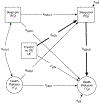Is improving sleep and circadian problems in adolescence a pathway to improved health? A mediation analysis
- PMID: 31246052
- PMCID: PMC6690778
- DOI: 10.1037/ccp0000423
Is improving sleep and circadian problems in adolescence a pathway to improved health? A mediation analysis
Abstract
Objective: The present study tested whether improvements in sleep and circadian problems mediate the effect of a novel transdiagnostic sleep and circadian intervention (TranS-C) on improvements in 5 health domains (emotional, cognitive, behavioral, social, and physical) in community-residing, evening chronotype adolescents who were at risk for problems in these 5 health domains.
Method: Participants were 176 adolescents (age mean [SD] = 14.77 [1.84] years; 58% female) who were randomized to receive 6 sessions of TranS-C or psychoeducation. Putative mediators tested were eveningness, weekday-weekend discrepancy in total sleep time and waketime, daytime sleepiness, Pittsburgh Sleep Quality Index score, and parent-reported sleep-wake problems. Risk in 5 health domains was measured using adolescent self-reported questionnaires, parent-reported Child Behavior Checklist, and ecological momentary assessment (EMA) of problems in the 5 health domains.
Results: Reduced eveningness mediated the effects of TranS-C on reducing both self-reported and parent-reported risk in the 5 health domains. Reduction in daytime sleepiness mediated the effects of TranS-C on parent-reported risk in the 5 health domains. Reduction in parent-reported sleep-wake problems mediated the effects of TranS-C on self-reported, parent-reported, and EMA-assessed risk in the 5 health domains. Results did not support the other hypothesized mediators.
Conclusions: TranS-C exerts effects on reducing risk in multiple mental and physical health domains through reducing sleep and circadian problems in evening chronotype adolescents. Further research of TranS-C in other samples to assess its benefits for sleep and circadian problems as well as mental and physical health is warranted. (PsycINFO Database Record (c) 2019 APA, all rights reserved).
Trial registration: ClinicalTrials.gov NCT01828320.
Figures



Similar articles
-
A transdiagnostic sleep and circadian intervention for adolescents: six-month follow-up of a randomized controlled trial.J Child Psychol Psychiatry. 2020 Jun;61(6):653-661. doi: 10.1111/jcpp.13154. Epub 2019 Nov 26. J Child Psychol Psychiatry. 2020. PMID: 31773734 Free PMC article. Clinical Trial.
-
Modifying the Impact of Eveningness Chronotype ("Night-Owls") in Youth: A Randomized Controlled Trial.J Am Acad Child Adolesc Psychiatry. 2018 Oct;57(10):742-754. doi: 10.1016/j.jaac.2018.04.020. Epub 2018 Aug 15. J Am Acad Child Adolesc Psychiatry. 2018. PMID: 30274649 Free PMC article. Clinical Trial.
-
Evening circadian preference is associated with sleep problems and daytime sleepiness in adolescents with ADHD.J Sleep Res. 2020 Feb;29(1):e12936. doi: 10.1111/jsr.12936. Epub 2019 Oct 25. J Sleep Res. 2020. PMID: 31651076 Free PMC article.
-
Chronotype-related differences in childhood and adolescent aggression and antisocial behavior--a review of the literature.Chronobiol Int. 2014 Feb;31(1):1-16. doi: 10.3109/07420528.2013.829846. Epub 2013 Oct 22. Chronobiol Int. 2014. PMID: 24147657 Review.
-
Circadian Rhythm Sleep-Wake Disorders.Continuum (Minneap Minn). 2017 Aug;23(4, Sleep Neurology):1051-1063. doi: 10.1212/CON.0000000000000499. Continuum (Minneap Minn). 2017. PMID: 28777176 Review.
Cited by
-
Delayed circadian rhythms and insomnia symptoms in obsessive-compulsive disorder.J Affect Disord. 2022 Dec 1;318:94-102. doi: 10.1016/j.jad.2022.08.118. Epub 2022 Sep 1. J Affect Disord. 2022. PMID: 36057288 Free PMC article.
-
Sleep to Internalizing Pathway in Young Adolescents (SIPYA): A proposed neurodevelopmental model.Neurosci Biobehav Rev. 2022 Sep;140:104780. doi: 10.1016/j.neubiorev.2022.104780. Epub 2022 Jul 14. Neurosci Biobehav Rev. 2022. PMID: 35843345 Free PMC article. Review.
-
Open trial of the Parent Behavior Change Intervention (PBC-I): Study protocol.Health Psychol. 2020 Sep;39(9):785-795. doi: 10.1037/hea0000873. Health Psychol. 2020. PMID: 32833480 Free PMC article.
-
A transdiagnostic sleep and circadian intervention for adolescents: six-month follow-up of a randomized controlled trial.J Child Psychol Psychiatry. 2020 Jun;61(6):653-661. doi: 10.1111/jcpp.13154. Epub 2019 Nov 26. J Child Psychol Psychiatry. 2020. PMID: 31773734 Free PMC article. Clinical Trial.
-
Prevention is better than cure: why early interventions for insomnia and chronic pain during adolescence should be a priority.Front Psychol. 2023 Jun 8;14:1206977. doi: 10.3389/fpsyg.2023.1206977. eCollection 2023. Front Psychol. 2023. PMID: 37359854 Free PMC article. No abstract available.
References
-
- Aaron DJ, & Kriska AM (1997). Modifiable activity questionnaire for adolescents. Medicine and Science in Sports and Exercise, 29, s79–s82.
-
- Achenbach TM, & Rescorla LA (2001). Manual for the ASEBA School-Age Forms & Profiles: Child Behavior Checklist for Ages 6 – 18, Teacher’s Report Form, & Youth Self-Report. Burlington, VT: University of Vermont, Research Center for Children, Youth & Families.
-
- Becker SP, Ramsey RR, & Byars KC (2015). Convergent validity of the Child Behavior Checklist sleep items with validated sleep measures and sleep disorder diagnoses in children and adolescents referred to a sleep disorders center. Sleep Medicine, 16(1), 79–86. 10.1016/j.sleep.2014.09.008 - DOI - PubMed

